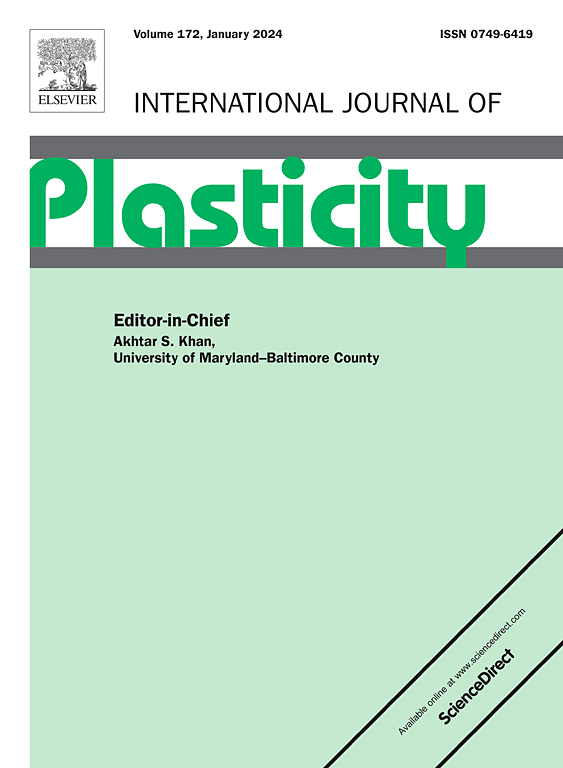Rapid assessment of the creep rupture life of metals: A model enabling experimental design
IF 12.8
1区 材料科学
Q1 ENGINEERING, MECHANICAL
引用次数: 0
Abstract
Prediction of the creep rupture life of engineering metals is critical for qualification and design of new materials. The use of long-term creep tests and the need to quantify the performance variability in a priori similar systems hinder the rapid creep assessment of a given material. Therefore, it is essential to develop methods that can extrapolate the long-term performance of alloys and the associated variability from short-term experiments. To this end, this study introduces a new model which enables the estimation of the rupture life of a material for a given stress and temperature. This model relies on two components. First, a new relation for the minimum creep rate (MCR) of materials is introduced. It includes a stress dependent stress exponent allowing the model to capture the variation of MCR across a wide range of temperatures and stresses. Second, employing the Monkman-Grant (MG) law, we establish a relation between stress, temperature and creep rupture life. Together, these two elements yield a new closed-form mathematical expression for the Larson Miller parameter as a function of stress and temperature. This expression captures the creep rupture time for many metals (Gr91, Copper, Gr122 and 347H) and compares favorably with alternate empirical approaches. The model is then used to assess the minimum duration of creep rates necessary to qualify the material up to 100000h. It is found that depending on the material system, creep tests as few as five limited to 5000 h for steels (Gr91, Gr122, 347H) and 100 h for copper are sufficient to model creep lifetimes. Finally, using a Bayesian inference-based approach to calibrate the model, we demonstrate that variability in rupture life can be captured via the quantification of the uncertainty in the model parameters and extrapolated from a limited number of short to moderately short creep tests; thereby paving the way for accelerated creep testing.
快速评估金属的蠕变断裂寿命:有助于实验设计的模型
工程金属的蠕变断裂寿命预测对于新材料的鉴定和设计至关重要。使用长期蠕变试验以及量化先验类似系统性能变异性的需要,阻碍了对特定材料进行快速蠕变评估。因此,必须开发能够从短期实验中推断合金长期性能和相关变异性的方法。为此,本研究引入了一个新模型,可估算给定应力和温度下材料的断裂寿命。该模型由两部分组成。首先,引入了材料最小蠕变速率(MCR)的新关系。它包括一个与应力相关的应力指数,使模型能够捕捉到 MCR 在各种温度和应力下的变化。其次,利用蒙克曼-格兰特(MG)定律,我们建立了应力、温度和蠕变断裂寿命之间的关系。这两个要素结合在一起,产生了拉森-米勒参数作为应力和温度函数的新闭式数学表达式。该表达式捕捉到了许多金属(Gr91、铜、Gr122 和 347H)的蠕变断裂时间,并与其他经验方法进行了比较。然后,利用该模型评估了使材料合格达 100000 小时所需的最小蠕变速率持续时间。研究发现,根据材料系统的不同,钢材(Gr91、Gr122、347H)的蠕变试验只要限制在 5000 小时以内,铜材的蠕变试验只要限制在 100 小时以内,就足以建立蠕变寿命模型。最后,我们使用基于贝叶斯推理的方法来校准模型,证明可以通过量化模型参数的不确定性来捕捉断裂寿命的变化,并从数量有限的短期至中度短期蠕变试验中推断出来;从而为加速蠕变试验铺平了道路。
本文章由计算机程序翻译,如有差异,请以英文原文为准。
求助全文
约1分钟内获得全文
求助全文
来源期刊

International Journal of Plasticity
工程技术-材料科学:综合
CiteScore
15.30
自引率
26.50%
发文量
256
审稿时长
46 days
期刊介绍:
International Journal of Plasticity aims to present original research encompassing all facets of plastic deformation, damage, and fracture behavior in both isotropic and anisotropic solids. This includes exploring the thermodynamics of plasticity and fracture, continuum theory, and macroscopic as well as microscopic phenomena.
Topics of interest span the plastic behavior of single crystals and polycrystalline metals, ceramics, rocks, soils, composites, nanocrystalline and microelectronics materials, shape memory alloys, ferroelectric ceramics, thin films, and polymers. Additionally, the journal covers plasticity aspects of failure and fracture mechanics. Contributions involving significant experimental, numerical, or theoretical advancements that enhance the understanding of the plastic behavior of solids are particularly valued. Papers addressing the modeling of finite nonlinear elastic deformation, bearing similarities to the modeling of plastic deformation, are also welcomed.
 求助内容:
求助内容: 应助结果提醒方式:
应助结果提醒方式:


